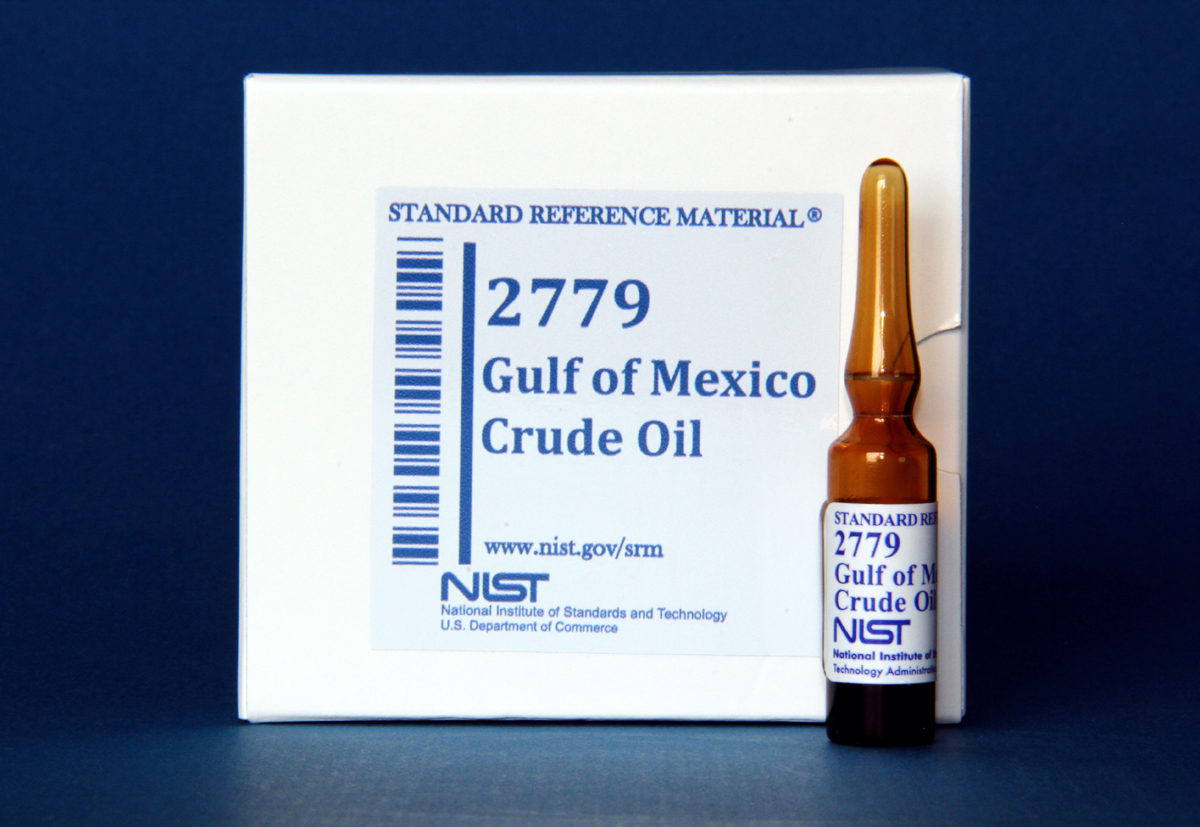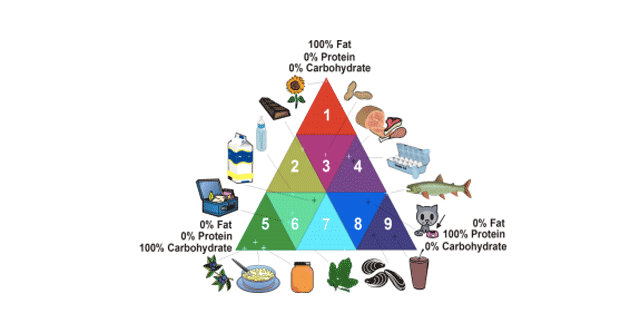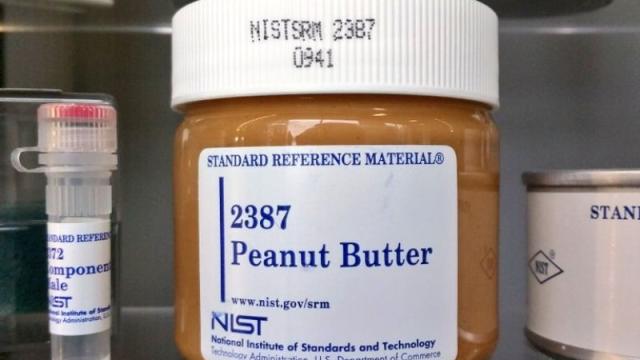The most expensive peanut butter in the world is sold by the US government. The $US761 jar of peanut butter, created to calibrate machines in food science labs, went viral last month. But “Standard Reference Material 2387”, aka peanut butter, is only the tip of the iceberg of a strange and fascinating world.
Even among government bureaucracies, the National Institute of Standards and Technology (NIST) might sound like an especially staid and boring place. Without NIST, though, science would be a mess, and so would be the rest our lives. NIST is the keeper of the official atomic clock, cryptography standards, and, relevant to the peanut butter curious, the Standard Reference Materials program.
If you look in the right places online, you can find a dazzling array of NIST products for sale. Peanut butter, of course, but also organics in whale blubber
(SRM 1945), baking chocolate (SRM 2384), lake sediment powder (SRM 4354), and nicotine metabolites in frozen human urine (SRM 3671). That’s just a small sampling of the over 1,300 reference materials catalogued by NIST.
None of these materials are for consumption — or whatever it is you would think to do with lake sediment powder. Rather, SRMs serve a very particular purpose: NIST carefully measures the chemical content of their SRMs. Industrial labs all over the world buy SRMs to vaporise inside their gas chromagraphs and mass spectrometers and other devices, comparing those readings against NIST’s so they know their instruments are accurate. Food labs testing fatty foods need a fatty reference material like peanut butter, petroleum labs need crude oil, and so on.
How does NIST decide what SRMs to make? Its chemists keep ears close to the ground in their various industries, and the institute also collaborates with other organisations like CDC and NOAA to support their research. Behind each reference material is a story of how it came to be. To find out some of these stories, I called up Stephen Wise, a senior analytical chemist and program coordinator at NIST.
Oil From Deepwater Horizon — $US545

When I asked Wise about bestsellers and, well, not-so-good sellers in the SRM, he recounted the story of petroleum crude oil. Several decades ago, NIST made reference materials for a number of collaborations with the Department of Energy. Many of them did not sell well, including even petroleum crude oil.
But then, in 2010, the Deepwater Horizon oil spill happened. As labs all over the country began to test oil samples, demand for petroleum crude oil spiked, until it eventually sold out. The original petroleum crude oil (SRM 1582) is no longer available, but NIST did made sure to collect oil from the Deepwater Horizon disaster itself. That oil, recovered by the drillship Discoverer Enterprise working in post-disaster response operators, is now SRM 2779.
Peanut Butter — $US761
You’re probably familiar with the food pyramid and maybe even the new food pyramid, but let me acquaint you with NIST’s food triangle. Food is primarily composed of one of three things: fat, protein, and carbs, which represent the triangle’s three points. NIST has no particular interest in peanut butter, but it does have an interest in having an even spread of SRMs all over the triangle. “W e pick a food based on where it fits in the triangle,” says Wise.

When NIST’s peanut butter was created about a decade ago, it was one of the first high-fat foods. (Labs testing high-fat foods will want to calibrate their machines with peanut butter rather than, say, frozen spinach.) NIST’s factsheet has all the information about peanut butter’s chemical makeup, but now does it taste? Back in 2013, the New York Times’s restaurant critic, William Grimes, had this review:
The government’s peanut butter tastes a lot better than it looks, which is like dark-brown industrial paste. I wasn’t sure whether to eat it or lay down some new bathroom tile. As a food product, it seemed to aim for dead average. The peanut flavour was muted, and it lacked the creamy, unctuous quality of storebought brands. If you like peanut butter to stick to the roof of your mouth, this is one for you
And why so expensive? We aren’t in the habit of purchasing whale blubber and urine metabolites (see below) at the grocery store, so the price of the peanut butter really stands out. Wise says it has do with the cost of testing the product.
Organics in Whale Blubber — $US639
When a pilot whale was stranded on land and died several years ago, Wise was there to collect its blubber and put it toward a good cause. Pollutants tend to travel up the food chain, accumulating most especially in whales, which sit at the top of the food chain. NIST has been working with the National Oceanic and Atmospheric Administration to develop materials for that research.
Wise says that at the time they had thought the whale blubber would also be a good surrogate for studying how pollutants accumulate in human fat, but the material hasn’t sold as well as they had hoped. One possible hang-up? It’s very difficult to ship whale blubber overseas because of restrictions trade restrictions made to protect whales. Ironically, those same restrictions may be making research that could help whales more difficult, too.
Freeze-Dried “Typical Diet” — $US912
The typical American diet is pretty processed, but the “typical diet” sold by NIST is extremely so: freeze-dried, homogenized, and powdered. In other words, very appropriate for calibrating instruments. The product was first produced about 20 years ago in conjunction with the USDA and FDA, which collected surveys, portioned out food, and cooked it according to an average American diet.
Wise says that their supply is currently running low, and NIST is thinking about creating a new batch. This time, even the NIST cafeteria is getting involved to prepare the food.
Drug Metabolites in Human Urine, Hair, and Serum — Variable
The strangest part of the SRM catalogue may be the array of human products: hair, urine, lung powder, liver powder, and a whole lot of serum. The products are also sorted by what they contain: THC, vitamin D, arsenic, etc.
NIST contracts with various companies which collect urine and blood from volunteers. (Wise mentions that many years ago, they used to get put urine donation bottles in the bathroom at NIST, but that doesn’t fly anymore.) Drugs are usually added after the fact, so no, NIST isn’t seeking out addicts to complete their urine and serum collection. But the certificate for “Drugs of Abuse From in Human Hair I,” which contains meth and cocaine, does have this line, haunting in its vagueness: “SRM 2379 is human hair from a single individual.”
Pictures: NIST
